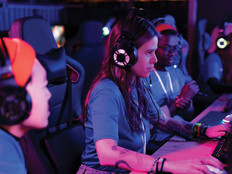Adding a Dash of VR to Class Is Possible with a Limited Budget
Immersive virtual reality experiences offer powerful ways to engage students and create new learning opportunities in the classroom. As the technology and awareness about using VR in education continue to mature, so do the options available for teachers.
Google Expeditions remains one of the most well-known options for teachers to consider. With the Expeditions app, teachers can take students on “virtual reality field trips” visiting far-away museums and exploring ancient ruins or natural wonders like Mount Everest.
Teachers can put together their own kits using less expensive cardboard viewers that cost $7-$10 each, as well as a tablet as a teacher device and, for the students, VR smartphone apps that can run on school Wi-Fi. Most smartphones purchased in the last three years will run VR apps and work with mobile VR headsets. Schools may also consider purchasing a set of Android phones or find a sponsor that may be able to donate new or refurbished devices for an initial VR project.
Nearpod VR has introduced its own approach to VR field trips, with emphasis on lesson plans complementing its 360-degree panoramic images. Nearpod offers school or district licenses along with individual bundles of VR lessons. Teachers should also look at the content offered by YouTube 360 videos and the innovative work by The New York Times. To get started, I recommend that teachers look at Google Arts and Culture, Discovery VR, Titans of Space, EON Experience VR and The New York Times VR (NYT VR) apps.
New VR Tech Is Perfect for Classrooms
In late 2016, Google released its Daydream View headset ($79) and Pixel phone. Daydream View is a lightweight, easy-to-wear device made with foam and fabric. It currently offers the best immersive experience on a mobile viewer and comes with an incredibly powerful hand controller. However, Daydream View is limited to Google's Pixel phone and only a handful of recently released phones. The viewer offers tremendous potential for education in the future when more phones are compatible.
The New Samsung Gear VR Headset will be available on April 21 for $129. I had the opportunity to preview it at Samsung 837, their innovative space in New York City. In terms of visual quality, the upgrade to the Gear VR software provides greatly improved the graphics, no doubt due to Samsung’s use of the latest Qualcomm Snapdragon 835 processor.
Early in 2017, Microsoft announced partnerships with Lenovo and others to build innovative VR headsets starting at $299. In April, Acer will ship the first units to developers. The headset will include the six degrees-of-freedom tracking necessary to enable deeply immersive experiences. Microsoft refers to these headsets as Mixed Reality (MR) devices as they have two front-facing cameras that can scan a room and reveal a grid when users get close to a wall. But unlike HoloLens, they’re tethered and not scanning objects in the room. In contrast to Oculus or HTC Vive, which require high-end computers, these headsets will run on the mid-range computers that most of us have. This will definitely make the headset appealing to educators.
With inexpensive headsets coming to the market, VR and MR may well be an affordable tool by the end of this year. Content remains a challenge, but I’m excited to see a growing community of K–12 educators sharing apps and lesson ideas online. My hope is that as less expensive headsets and 360-cameras become available, both students and teachers will not only be viewers, but also creators in virtual reality. We are on the cusp of an exciting transformation in the way we experience and learn about ourselves and the world.








